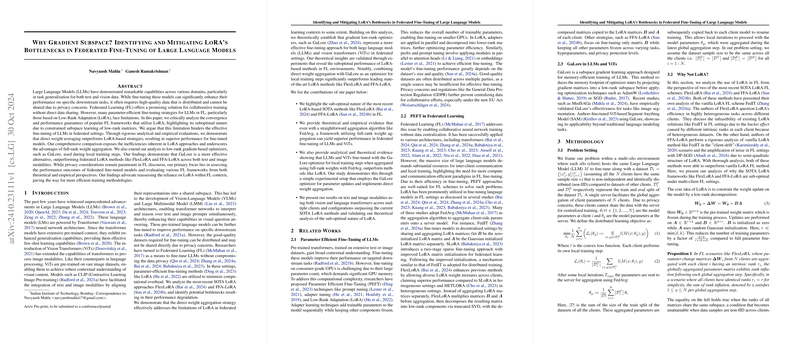Analysis of LoRA Constraints in Federated Fine-Tuning of LLMs
The paper examines the limitations inherent in parameter-efficient fine-tuning strategies, specifically Low-Rank Adaptation (LoRA), within federated settings when applied to LLMs. Federated Learning (FL) facilitates collaborative training without requiring data centralization, thereby maintaining data privacy—a crucial advantage given the current regulatory landscape. This paper exposes the bottlenecks that arise due to LoRA's constrained low-rank subspace learning limitations and proposes alternative methodologies that outperform LoRA in federated environments through both analytical rigour and empirical evaluations.
Examination of LoRA in Federated Contexts
The research scrutinizes the efficacy of recent LoRA-based FL methods like FlexLoRA and FFA-LoRA, which have limitations despite fine-tuning capabilities being integrated to minimize computational overhead. Theoretically, the paper argues that the aggregation of low-rank matrices in federated settings leads to progressive rank inflation with each global aggregation step. This rank inflation inherently limits the model's ability to capture local data distribution effectively. Analytical evidence provides that both methods demonstrate a suboptimal aggregation strategy, leading to a substantial performance drop in distributed settings.
Alternative Methodologies: Direct Weight Averaging and GaLore Integration
To address LoRA's bottlenecks, the paper suggests transitioning to direct weight averaging combined with a low-rank gradient-based optimizer, GaLore. GaLore stands as a more effective paradigm for federated fine-tuning by managing computational complexities through projecting gradients into a low-rank subspace, improving memory efficiency without sacrificing model generalization capabilities. The paper highlights reduced generalization errors and consistent performance improvements across various FL configurations, underpinning GaLore's robustness.
The paper establishes performance bounds for direct weight averaging, positing that its risk bounds, independent of client number, facilitate consistency across diverse client distributions—a stark contrast to the observed decline in LoRA-based methods as client numbers increase. GaLore optimizations are shown to enhance both computation efficiency and generalization error bounds, offering an improved strategy over traditional full gradient descent.
FedFTG: Proposed Federated Fine-Tuning Framework
The proposed framework, Federated Fine-Tuning using GaLore (FedFTG), capitalizes on GaLore's memory-efficient subspace learning by focusing on fine-tuning the lower MLP layers of neural networks. The framework successfully builds upon insights from theoretical models to prevent excess risk and rank inflation commonly faced in LoRA-based federated learning environments. Empirical results demonstrate improvements in both convergence and model performance consistency across multiple datasets, including both text and image modalities.
Experimental Validation and Results
Rigorous experiments underscore the efficacy of FedFTG. Across datasets like MedQuAD and Dolly-15K and using models such as TinyLlama and Gemma-2B, FedFTG consistently delivers superior performance over FlexLoRA and FFA-LoRA. This extensibility across datasets and client configurations citing both BLEU and ROUGE-L scores negates LoRA's drawbacks with enhanced stability and reduced overfitting risks.
Implications and Future Directions
The findings advocate for a reconsideration of the current dependence on LoRA within federated setups. By leveraging GaLore, the paper presents a strong case for more optimal, memory-efficient fine-tuning frameworks, paving the way for more effective federated learning methodologies. Future work will benefit from further exploring adaptive aggregation strategies to accommodate heterogeneous data distributions, potentially enhancing the use of low-rank gradient-based optimization in broader settings.
This paper ultimately marks significant headway toward optimizing federated learning frameworks for LLMs by tackling well-documented limitations of low-rank approximations like LoRA, concurrently guiding the research community towards innovative solutions in maintaining model performance and consistency in federated ecosystems.
